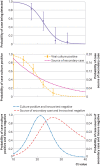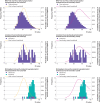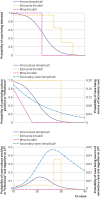SARS-CoV-2 antigen lateral flow tests for detecting infectious people: linked data analysis
- PMID: 35197270
- PMCID: PMC8864475
- DOI: 10.1136/bmj-2021-066871
SARS-CoV-2 antigen lateral flow tests for detecting infectious people: linked data analysis
Abstract
Objectives: To investigate the proportion of lateral flow tests (LFTs) that produce negative results in those with a high risk of infectiousness from SARS-CoV-2, to investigate the impact of the stage and severity of disease, and to compare predictions made by influential mathematical models with findings of empirical studies.
Design: Linked data analysis combining empirical evidence of the accuracy of the Innova LFT, the probability of positive viral culture or transmission to secondary cases, and the distribution of viral loads of SARS-CoV-2 in individuals in different settings.
Setting: Testing of individuals with symptoms attending NHS Test-and-Trace centres across the UK, residents without symptoms attending municipal mass testing centres in Liverpool, and students without symptoms screened at the University of Birmingham.
Participants: Evidence for the sensitivity of the Innova LFT, based on 70 individuals with SARS-CoV-2 and LFT results. Infectiousness was based on viral culture rates on 246 samples (176 people with SARS-CoV-2) and secondary cases among 2 474 066 contacts; distributions of cycle threshold (Ct) values from 231 497 index individuals attending NHS Test-and-Trace centres; 70 people with SARS-CoV-2 detected in Liverpool and 62 people with SARS-CoV-2 in Birmingham (54 imputed).
Main outcome measures: The predicted proportions who were missed by LFT and viral culture positive and missed by LFT and sources of secondary cases, in each of the three settings. Predictions were compared with those made by mathematical models.
Results: The analysis predicted that of those with a viral culture positive result, Innova would miss 20% attending an NHS Test-and-Trace centre, 29% without symptoms attending municipal mass testing, and 81% attending university screen testing without symptoms, along with 38%, 47%, and 90% of sources of secondary cases. In comparison, two mathematical models underestimated the numbers of missed infectious individuals (8%, 10%, and 32% in the three settings for one model, whereas the assumptions from the second model made it impossible to miss an infectious individual). Owing to the paucity of usable data, the inputs to the analyses are from limited sources.
Conclusions: The proportion of infectious people with SARS-CoV-2 missed by LFTs is substantial enough to be of clinical importance. The proportion missed varied between settings because of different viral load distributions and is likely to be highest in those without symptoms. Key models have substantially overestimated the sensitivity of LFTs compared with empirical data. An urgent need exists for additional robust well designed and reported empirical studies from intended use settings to inform evidence based policy.
© Author(s) (or their employer(s)) 2019. Re-use permitted under CC BY-NC. No commercial re-use. See rights and permissions. Published by BMJ.
Conflict of interest statement
Competing interests: All authors have completed the ICMJE uniform disclosure form at www.icmje.org/disclosure-of-interest/ and declare: JJD is member of the Medicines and Healthcare Products Regulatory Agency’s In-Vitro Diagnostics external advisory group and contributed to the Birmingham University evaluation of Innova. He has grant funding from The Foundation for Innovative New Diagnostics for the Cochrane review evaluating the accuracy of tests for SARS-CoV-2. AJS reports National Institute for Health Research /UK Research and Innovation funds separate to this study. no support from any organisation for the submitted work; no financial relationships with any organisations that might have an interest in the submitted work in the previous three years; no other relationships or activities that could appear to have influenced the submitted work.
Figures



References
-
- Department of Health and Social Care. Guidance: Understanding lateral flow antigen testing for people without symptoms. Updated 23 April 2021. www.gov.uk/guidance/understanding-lateral-flow-antigen-testing-for-peopl....
-
- Department of Health and Social Care. Guidance: Guidance on care home visiting. Updated 14 May 2021. www.gov.uk/government/publications/visiting-care-homes-during-coronaviru....
-
- Department of Business Energy & Industrial Strategy. Department for Digital Culture, Media & Sport; Department of Health and Social Care. Notice: Information on the Events Research Programme. Updated 19 April 2021. www.gov.uk/government/publications/guidance-about-the-events-research-pr....
Publication types
MeSH terms
Substances
LinkOut - more resources
Full Text Sources
Other Literature Sources
Medical
Miscellaneous
